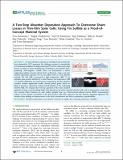| dc.contributor.author | Yang, Chuanxi | |
| dc.contributor.author | Moriarty, Tom | |
| dc.contributor.author | Gordon, Roy G. | |
| dc.contributor.author | Buonassisi, Tonio | |
| dc.contributor.author | Steinmann, Vera | |
| dc.contributor.author | Chakraborty, Rupak | |
| dc.contributor.author | Rekemeyer, Paul Harlan | |
| dc.contributor.author | Hartman, Katherine | |
| dc.contributor.author | Brandt, Riley E | |
| dc.contributor.author | Polizzotti, James Alexander | |
| dc.contributor.author | Gradecak, Silvija | |
| dc.date.accessioned | 2017-09-07T16:25:10Z | |
| dc.date.available | 2017-09-07T16:25:10Z | |
| dc.date.issued | 2016-08 | |
| dc.date.submitted | 2016-06 | |
| dc.identifier.issn | 1944-8244 | |
| dc.identifier.issn | 1944-8252 | |
| dc.identifier.uri | http://hdl.handle.net/1721.1/111150 | |
| dc.description.abstract | As novel absorber materials are developed and screened for their photovoltaic (PV) properties, the challenge remains to reproducibly test promising candidates for high-performing PV devices. Many early-stage devices are prone to device shunting due to pinholes in the absorber layer, producing “false-negative” results. Here, we demonstrate a device engineering solution toward a robust device architecture, using a two-step absorber deposition approach. We use tin sulfide (SnS) as a test absorber material. The SnS bulk is processed at high temperature (400 °C) to stimulate grain growth, followed by a much thinner, low-temperature (200 °C) absorber deposition. At a lower process temperature, the thin absorber overlayer contains significantly smaller, densely packed grains, which are likely to provide a continuous coating and fill pinholes in the underlying absorber bulk. We compare this two-step approach to the more standard approach of using a semi-insulating buffer layer directly on top of the annealed absorber bulk, and we demonstrate a more than 3.5× superior shunt resistance R[subscript sh] with smaller standard error σ[subscript Rsh]. Electron-beam-induced current (EBIC) measurements indicate a lower density of pinholes in the SnS absorber bulk when using the two-step absorber deposition approach. We correlate those findings to improvements in the device performance and device performance reproducibility. | en_US |
| dc.description.sponsorship | United States. Department of Energy (EEC-1041895) | en_US |
| dc.description.sponsorship | United States. Department of Energy (Contract DE-EE0005329) | en_US |
| dc.language.iso | en_US | |
| dc.publisher | American Chemical Society (ACS) | en_US |
| dc.relation.isversionof | http://dx.doi.org/10.1021/acsami.6b07198 | en_US |
| dc.rights | Article is made available in accordance with the publisher's policy and may be subject to US copyright law. Please refer to the publisher's site for terms of use. | en_US |
| dc.source | Other univ. web domain | en_US |
| dc.title | A Two-Step Absorber Deposition Approach To Overcome Shunt Losses in Thin-Film Solar Cells: Using Tin Sulfide as a Proof-of-Concept Material System | en_US |
| dc.type | Article | en_US |
| dc.identifier.citation | Steinmann, Vera et al. “A Two-Step Absorber Deposition Approach To Overcome Shunt Losses in Thin-Film Solar Cells: Using Tin Sulfide as a Proof-of-Concept Material System.” ACS Applied Materials & Interfaces 8, 34 (August 2016): 22664–22670 © 2016 American Chemical Society | en_US |
| dc.contributor.department | Massachusetts Institute of Technology. Department of Materials Science and Engineering | en_US |
| dc.contributor.department | Massachusetts Institute of Technology. Department of Mechanical Engineering | en_US |
| dc.contributor.mitauthor | Steinmann, Vera | |
| dc.contributor.mitauthor | Chakraborty, Rupak | |
| dc.contributor.mitauthor | Rekemeyer, Paul Harlan | |
| dc.contributor.mitauthor | Hartman, Katherine | |
| dc.contributor.mitauthor | Brandt, Riley E | |
| dc.contributor.mitauthor | Polizzotti, James Alexander | |
| dc.contributor.mitauthor | Gradecak, Silvija | |
| dc.relation.journal | ACS Applied Materials & Interfaces | en_US |
| dc.eprint.version | Author's final manuscript | en_US |
| dc.type.uri | http://purl.org/eprint/type/JournalArticle | en_US |
| eprint.status | http://purl.org/eprint/status/PeerReviewed | en_US |
| dspace.orderedauthors | Steinmann, Vera; Chakraborty, Rupak; Rekemeyer, Paul H.; Hartman, Katy; Brandt, Riley E.; Polizzotti, Alex; Yang, Chuanxi; Moriarty, Tom; Gradečak, Silvija; Gordon, Roy G.; Buonassisi, Tonio | en_US |
| dspace.embargo.terms | N | en_US |
| dc.identifier.orcid | https://orcid.org/0000-0001-6715-5195 | |
| dc.identifier.orcid | https://orcid.org/0000-0002-7043-5048 | |
| dc.identifier.orcid | https://orcid.org/0000-0002-5901-9027 | |
| dc.identifier.orcid | https://orcid.org/0000-0003-2785-552X | |
| dc.identifier.orcid | https://orcid.org/0000-0002-8723-8024 | |
| mit.license | PUBLISHER_POLICY | en_US |
